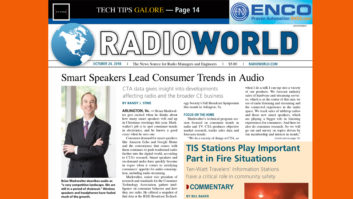(click thumbnail)It’s been a long time coming, but the FCC’s recent approval of (almost) final rules for U.S. digital radio is being welcomed widely by the industry.
There was no real surprise or drama to the Second Report & Order, and perhaps its most notable attribute is the ratification of what has become an interim status quo for broadcasters, while approving almost everything broadcasters were hoping to see included.
As expected — and as forecast here as far back as 2003 — there will be no mandatory conversion to IBOC, so broadcasters can proceed to implement IBOC at their own pace (or not at all).
More important, the rules codify into standard practice some important elements that had been allowed previously, but which required notification or approval under interim rules, i.e., FM-IBOC multicasting, datacasting, dual-antenna operation and operating in Extended Hybrid mode.
Major Change
For those heavily engaged with the day-to-day of IBOC conversion of late, it might bear recollection that multicasting was not even on the table when the interim rules were issued in 2002. (You might also remember this column’s repeated calls for such flexibility in IBOC application, without which it was felt that the success of the format would be severely threatened.)
Thus this rule represents a major regulatory change, even though during the five years between the First and Second R&O, multicasting has been incorporated in the NRSC-5-A standard, and meanwhile become commonplace among IBOC broadcasts, as well as a being standard feature in current IBOC receivers.
On the other hand, Extended Hybrid operation has not yet been widely implemented by broadcasters, and perhaps now it will be. This should substantially help FM broadcasters configure their digital multiplexes, providing even greater flexibility with which to assign payload (up to 146 kbps) among multiple audio and data services.
Note that Extended Hybrid operation can provide over 50 percent increase in digital capacity for FM-IBOC, which is proportionally more than any eventual All-Digital operation would incrementally add, and it does so without significantly affecting existing analog service. (In fact, the Second R&O explicitly prohibits broadcasters from switching to all-digital operations.)
Thus Extended Hybrid mode may become the sweet spot for analog/digital transitional operation, and could soon become the typical operating mode for FM-IBOC digital broadcasting.
Note also that the new rules offer almost complete freedom for broadcasters in their allocation of this payload among audio and data services, including the ability to offer bandwidth for sale to third parties (with some business constraints).
The new rules also clarify that IBOC may be used, where feasible, on FM translators, boosters and LPFM stations, which had been an uncertain area. This should stimulate the availability of broadcast equipment products specifically targeting such applications soon.
AM Unchained
Probably the biggest substantive change implemented by these rules is the allowance of nighttime IBOC operation for AM broadcasters, which had been nearly totally disallowed under the interim rules.
While some question the wisdom of this, it likely will encourage more AM broadcasters to convert to IBOC, and this could stimulate the long-awaited renaissance of the senior broadcast band. (It could also have the effect of increasing listener complaints, and it appears the FCC is gearing up for this possibility as well.)
Under optimum conditions, the audio quality improvement of AM-IBOC over analog AM is impressive, and will likely not be lost on existing users of AM. (Neither will the addition of metadata, which has never been practical for AM stations to provide in the analog world.) Whether these improvements will drive significant numbers of new listeners to the band remains to be seen, of course.
These advances will not come without some pain, however, including the reduction in analog bandwidth, the elimination of C-QUAM stereo for the few operations that might still be using it, and the likelihood of additional interference to long-distance nighttime reception. Whether a net benefit to the AM band results will also take some time to determine, but at least now this process can begin in earnest.
Trickle-down Effects
There are a few indirect effects that could result from the FCC’s action here.
One is that consumer electronics equipment manufacturers will now have one less excuse to hold back from developing IBOC products, now that final rules are in place. The FCC’s digital radio proceeding further underscores this assurance with its First Order on Reconsideration, which dismisses previously pending Petitions for Reconsideration and Rulemaking that questioned the selection of Ibiquity’s IBOC technology as the sole U.S. digital radio format.
Thus the lukewarm level of digital radio receiver introductions to date may experience a shift to a more substantial growth rate over the next several years.
Although year-to-year growth of available IBOC receiver models is already relatively strong, there is still a long way to go, and the milestone of leading manufacturers like Sony and Panasonic offering a broad spectrum of IBOC products has yet to be achieved. If this now occurs, it should bolster consumer confidence in the format, which in turn could add to the IBOC uptake rate significantly.
Added competition and economies of scale in the receiver market also should force prices downward, further stimulating consumer adoption. Combined with the expected introduction of portable IBOC receivers soon, IBOC penetration may begin to become significant.
Another area that may be improved by the new rules is the simple factor of consumer awareness. News on the regulatory front often generates significant coverage in mainstream press, and every little bit can help increase the low awareness levels among consumers for digital terrestrial radio in the country.
It will also be interesting to see if increased notice comes to IBOC from broadcasters and regulators outside the United States as a result of the commission’s action.
Finally, if worst-case scenarios play out on the current Internet radio music-royalty and satellite radio merger fronts, U.S. terrestrial digital radio might also indirectly benefit, so the growth of receiver availability and consumer awareness may come at a particularly opportune time.
On the Other Hand
There are some areas where the Second R&O adds or clarifies constraints to broadcasters.
These include the requirement that the IBOC main program service (MPS) must remain freely available and be “of at least comparable audio quality” to the analog signal. The latter is not likely to be a problem for AM broadcasters, but could be for FM, and one wonders how it would actually be determined or enforced.
The inclusion of this requirement is probably intended — at least conceptually — to prevent broadcasters from co-opting IBOC service into an unrelated business opportunity, and to keep IBOC as a step forward for traditional broadcasting and its general audience, while allowing incremental growth, within reason, into other new areas.
Multicast streams also are now clarified to be subject to all the same regulatory requirements as main channels in terms of programming and operational rules (including EAS, station- and sponsorship-identification, political broadcasting and indecency regulations).
While this was the likely expectation in the minds of most broadcasters all along, the actual existence of this rule may now stimulate a more real consideration of multicast streams as serious business, so they will no longer be treated as a novelty or experimental offering — as has sometimes been the case.
Still TBD
The FCC has left open a few areas of digital radio regulation for possible further rulemaking.
These include rules surrounding subscription radio offerings, and the option of additional public interest requirements for multicast services. An NPRM seeking comment on these two areas was issued along with the Second R&O.
The latter issue was also noted in partial dissents on the Second R&O by Commissioners Adelstein and Copps, who stated that they would have preferred more encouragements or requirements in the rules for broadcasters to use multicast services to increase localism, diversity and other public-interest content.
Also deferred was any decision on content protection for copyrighted material (i.e., published music) broadcast on IBOC services, or any rules surrounding consumers’ downstream use of such material recorded off-air by listeners, which the RIAA has favored. The commission felt such deferral was appropriate given that these issues are still under debate in other industry and governmental venues.
So while true and fully final IBOC rules are still pending, most broadcasters have found a lot to like in the commission’s recent digital radio actions, and feel they’ve been well worth waiting for.
The FCC’s action is a big green light for IBOC and particularly for its application in a flexible form, which should provide it with the most favorable climate in which to succeed. This should help stoke the slowly accelerating U.S. digital radio engine and potentially kick it into the next gear.













